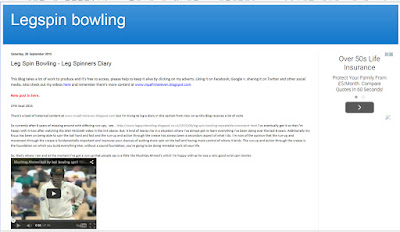I
don't know what it is Gundalf: perhaps something to do with the 2-piece balls
Sean uses for practice. The seam is quite prominant. Maybe the ball surface has
other characteristics that make it behave that way.
Dave, you'll probably get your head around it more if you consider that the Magnus effect is at its maximum when the ball is moving through the air perpendicularly to the axis of rotation. I've recently been writing about drift and it'll be here with images and diagrams hopefully illustrating what's going on with http://www.mpafirsteleven.blogspot.co.uk/2014/12/wrist-spin-bowling-leg-break.html
30th Dec 2015
Taken at one extreme (top spin) the axis of rotation is horizontal and across the pitch, so the ball is being forced down throughout its flight.
At the other extreme of pure side spin, the axis of rotation is along the pitch and the Magnus effect is not active while the ball is moving essentially parallel to that axis of rotation (ie the first "flat" portion of flight). It is only when the downward component of the flight starts to increase that the magnus effect comes into play in this case. As the vertical speed of the ball increases in the later part of the flight, the ball will start to move towards the leg side (for a RH leggie) because the ball is now moving perpendicularly to the axis of rotation more quickly.
For a 45 degree angle on the seam, there is a component of the Magnus effect working throughout the flight of the ball, but it's higher on the downward path of the delivery than the initial upward and flat path.
Because the downward path of the flight is so vital for drift on a side spinning and 45 degree spinning ball, it's imperitive that a good loopy flight is offered. Without that initial upward and subsequent flatter component to the delivery, there will be no late drift in the flight (there may be constant drift, but it won't be significant nor particularly tricky to handle).
It all comes down to the flow of air ACROSS the axis of rotation.
To get drift from a ball that will also turn off the pitch, there must be a loopy flight so that downward speed has a chance to increase during the delivery. It's the change in vertical speed that alters the drift in the air for a side-spinning delivery.
Cheers,
Graeme
Read more: http://spin-bowling.boards.net/index.cgi?board=discussions&action=display&thread=22&page=1#ixzz28byO84YA
I'm still struggling to get my head round drift, but this explanation is quite interesting. The interesting thing I picked up on was the dynamics of the drop from the trajectory and the fact that the 'Drop' aspect adds a different dimention. I've not got time at the minute to try and digest the info and make sense of it, but I may come back to it at some point later.
Check out my other blog here - this is all about Leg-spin bowling and nothing else. Double click on the image below.
Dave, you'll probably get your head around it more if you consider that the Magnus effect is at its maximum when the ball is moving through the air perpendicularly to the axis of rotation. I've recently been writing about drift and it'll be here with images and diagrams hopefully illustrating what's going on with http://www.mpafirsteleven.blogspot.co.uk/2014/12/wrist-spin-bowling-leg-break.html
30th Dec 2015
Taken at one extreme (top spin) the axis of rotation is horizontal and across the pitch, so the ball is being forced down throughout its flight.
At the other extreme of pure side spin, the axis of rotation is along the pitch and the Magnus effect is not active while the ball is moving essentially parallel to that axis of rotation (ie the first "flat" portion of flight). It is only when the downward component of the flight starts to increase that the magnus effect comes into play in this case. As the vertical speed of the ball increases in the later part of the flight, the ball will start to move towards the leg side (for a RH leggie) because the ball is now moving perpendicularly to the axis of rotation more quickly.
For a 45 degree angle on the seam, there is a component of the Magnus effect working throughout the flight of the ball, but it's higher on the downward path of the delivery than the initial upward and flat path.
Because the downward path of the flight is so vital for drift on a side spinning and 45 degree spinning ball, it's imperitive that a good loopy flight is offered. Without that initial upward and subsequent flatter component to the delivery, there will be no late drift in the flight (there may be constant drift, but it won't be significant nor particularly tricky to handle).
It all comes down to the flow of air ACROSS the axis of rotation.
To get drift from a ball that will also turn off the pitch, there must be a loopy flight so that downward speed has a chance to increase during the delivery. It's the change in vertical speed that alters the drift in the air for a side-spinning delivery.
Cheers,
Graeme
Read more: http://spin-bowling.boards.net/index.cgi?board=discussions&action=display&thread=22&page=1#ixzz28byO84YA
I'm still struggling to get my head round drift, but this explanation is quite interesting. The interesting thing I picked up on was the dynamics of the drop from the trajectory and the fact that the 'Drop' aspect adds a different dimention. I've not got time at the minute to try and digest the info and make sense of it, but I may come back to it at some point later.
Check out my other blog here - this is all about Leg-spin bowling and nothing else. Double click on the image below.
